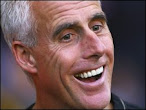Its the stadium that the mighty Wolves turn out at every other week more or less but do you know everything about it? Well if not here is a guide to our great ground Molineux Stadium.
The stadium is located within a mile of Wolverhampton city centre, just outside of the city's ring road, and is a prominent building because of its size. It consists of four stands: the Steve Bull Stand (formerly the John Ireland stand), the Jack Harris Stand, the Stan Cullis Stand and the Billy Wright Stand. In front of the Billy Wright Stand is a statue of the player, who made 105 appearances for England, 90 of them as captain. In front of the Stan Cullis stand is a statue of the former player, captain and manager who led the team during their most successful era.
The total seated capacity of the ground is approximately 28,525. This was expanded in 2003 by the building of a temporary stand, known as the Graham Hughes Stand, providing capacity for another 900 fans. These temporary seats were removed before the beginning of the 2006/07 season. In the days before the Taylor Report, which required British football stadia to provide seating for all those attending, the ground had a capacity of over 60,000; the record attendance for a match at the ground is 61,315 for a game against Liverpool on 11 February 1939.
Molineux has hosted England internationals. The first was a 6-1 win over Ireland on March 7, 1891 (the same day England also beat Wales 4-1 at Sunderland's ground). England again beat Ireland, this time 4-0, on February 14, 1903 and lost to Wales 2-1 on February 5, 1936. The last was a 5-2 defeat of Denmark in a 1958 World Cup qualifier on December 5, 1956. In 2005, Molineux hosted some of the European Youth Championship qualifying matches, which featured Mark Davies.
On June 24, 2003, Molineux also became Wolverhampton's biggest live concert venue, with Bon Jovi performing in front of 34,000 people.
The Molineux name originates from Benjamin Molineux, a local merchant who purchased a plot of land in Wolverhampton in 1744, and built his home, Molineux House (later converted to the Molineux Hotel), within this. The estate was purchased in 1860 by O.E. McGregor, who converted the land into a pleasure park open to the public. Molineux Grounds, as it was titled, included a wide range of facilities including an ice rink, a cycling track, a boating lake and, most crucially, an area for football.
The grounds were sold to the Northampton Brewery in 1889, who rented its use to Wolverhampton Wanderers, who had previously lacked a permanent home. After renovating the site, the first ever league game was staged on September 7, 1889 in a 2-0 victory over Notts County before a crowd of 4,000.
Wolves bought the freehold in 1923 for £5,607 and soon set about constructing a major grandstand on the Waterloo Road side. In 1932, the club also built a new stand on the Molineux Street side and followed this with adding a roof to the South Bank two years later. The stadium finally now had four stands, which formed Molineux for the next half century.
In 1953, the club became one of the first to install floodlights, at a cost of around £10,000. The first ever floodlit game was held on September 30, 1953, as Wolves won 3-1 against South Africa. The addition of the floodlights opened the door for Molineux to host a series of midweek friendlies against teams from across the globe. In these days prior to the formation of the European Cup and international club competitions, these games were highly prestigious and gained huge crowds and interest, the BBC often televising such events. A new taller set was later installed in 1957, at a cost of £25,000, as the stadium prepared to host its first European Cup games.
The takeover of the club and stadium by Sir Jack Hayward in 1990 paved the way for redevelopment, which was further prompted by legislation following the Taylor Report that outlawed terraces which affected Premier League and Division One stadiums from the 1993-94 season.
The North Bank terrace was demolished in October 1991, and, the following summer, the new Stan Cullis Stand was completed in time for the 1992-93 season. Next came the demolition of the Waterloo Road Stand, with the new Billy Wright Stand taking its place several months later. The final phase of the redevelopment came in November 1993, when the new Jack Harris Stand was opened on the site of the South Bank terrace.
The newly-renovated stadium was officially opened on December 7, 1993, in a friendly with Honved, the Hungarian team who had been beaten in one of Molineux's most famous original floodlit friendlies. Molineux, with an all-seated capacity of 28,525, was then one of the largest stadiums in England, although this figure has since been exceeded by other new or revamped stadia.
In 2003, the John Ireland Stand was renamed the Steve Bull Stand (in honour of the club's highest goalscorer of all time), and at the same time the south-west corner of the ground was filled with 900 temporary seats, known as the Graham Hughes Stand, which, until their removal in the summer of 2006, raised the Molineux capacity to 29,396. This expansion occurred when Wolves were promoted to the Premier League, but they lasted just one season at this level.
In 2008, Chairman Steve Morgan revealed tentative plans to redevelop the stadium in order to bring the stands closer to the pitch. This would also increase the capacity to 40,000.
So there is pretty much everything you need to know about our beloved stadium.
The stadium is located within a mile of Wolverhampton city centre, just outside of the city's ring road, and is a prominent building because of its size. It consists of four stands: the Steve Bull Stand (formerly the John Ireland stand), the Jack Harris Stand, the Stan Cullis Stand and the Billy Wright Stand. In front of the Billy Wright Stand is a statue of the player, who made 105 appearances for England, 90 of them as captain. In front of the Stan Cullis stand is a statue of the former player, captain and manager who led the team during their most successful era.
The total seated capacity of the ground is approximately 28,525. This was expanded in 2003 by the building of a temporary stand, known as the Graham Hughes Stand, providing capacity for another 900 fans. These temporary seats were removed before the beginning of the 2006/07 season. In the days before the Taylor Report, which required British football stadia to provide seating for all those attending, the ground had a capacity of over 60,000; the record attendance for a match at the ground is 61,315 for a game against Liverpool on 11 February 1939.
Molineux has hosted England internationals. The first was a 6-1 win over Ireland on March 7, 1891 (the same day England also beat Wales 4-1 at Sunderland's ground). England again beat Ireland, this time 4-0, on February 14, 1903 and lost to Wales 2-1 on February 5, 1936. The last was a 5-2 defeat of Denmark in a 1958 World Cup qualifier on December 5, 1956. In 2005, Molineux hosted some of the European Youth Championship qualifying matches, which featured Mark Davies.
On June 24, 2003, Molineux also became Wolverhampton's biggest live concert venue, with Bon Jovi performing in front of 34,000 people.
The Molineux name originates from Benjamin Molineux, a local merchant who purchased a plot of land in Wolverhampton in 1744, and built his home, Molineux House (later converted to the Molineux Hotel), within this. The estate was purchased in 1860 by O.E. McGregor, who converted the land into a pleasure park open to the public. Molineux Grounds, as it was titled, included a wide range of facilities including an ice rink, a cycling track, a boating lake and, most crucially, an area for football.
The grounds were sold to the Northampton Brewery in 1889, who rented its use to Wolverhampton Wanderers, who had previously lacked a permanent home. After renovating the site, the first ever league game was staged on September 7, 1889 in a 2-0 victory over Notts County before a crowd of 4,000.
Wolves bought the freehold in 1923 for £5,607 and soon set about constructing a major grandstand on the Waterloo Road side. In 1932, the club also built a new stand on the Molineux Street side and followed this with adding a roof to the South Bank two years later. The stadium finally now had four stands, which formed Molineux for the next half century.
In 1953, the club became one of the first to install floodlights, at a cost of around £10,000. The first ever floodlit game was held on September 30, 1953, as Wolves won 3-1 against South Africa. The addition of the floodlights opened the door for Molineux to host a series of midweek friendlies against teams from across the globe. In these days prior to the formation of the European Cup and international club competitions, these games were highly prestigious and gained huge crowds and interest, the BBC often televising such events. A new taller set was later installed in 1957, at a cost of £25,000, as the stadium prepared to host its first European Cup games.
The takeover of the club and stadium by Sir Jack Hayward in 1990 paved the way for redevelopment, which was further prompted by legislation following the Taylor Report that outlawed terraces which affected Premier League and Division One stadiums from the 1993-94 season.
The North Bank terrace was demolished in October 1991, and, the following summer, the new Stan Cullis Stand was completed in time for the 1992-93 season. Next came the demolition of the Waterloo Road Stand, with the new Billy Wright Stand taking its place several months later. The final phase of the redevelopment came in November 1993, when the new Jack Harris Stand was opened on the site of the South Bank terrace.
The newly-renovated stadium was officially opened on December 7, 1993, in a friendly with Honved, the Hungarian team who had been beaten in one of Molineux's most famous original floodlit friendlies. Molineux, with an all-seated capacity of 28,525, was then one of the largest stadiums in England, although this figure has since been exceeded by other new or revamped stadia.
In 2003, the John Ireland Stand was renamed the Steve Bull Stand (in honour of the club's highest goalscorer of all time), and at the same time the south-west corner of the ground was filled with 900 temporary seats, known as the Graham Hughes Stand, which, until their removal in the summer of 2006, raised the Molineux capacity to 29,396. This expansion occurred when Wolves were promoted to the Premier League, but they lasted just one season at this level.
In 2008, Chairman Steve Morgan revealed tentative plans to redevelop the stadium in order to bring the stands closer to the pitch. This would also increase the capacity to 40,000.
So there is pretty much everything you need to know about our beloved stadium.
Subscribe to:
Post Comments (Atom)




0 comments:
Post a Comment